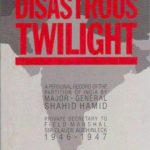Brig Agha Ahmad Gul, (Retd)
A nation state needs a military system. Military system is meant to counter the perceived external threats and also to manage internal socio-political upheavals to preserve and achieve national interests, aims and objectives. Military system starts from the lowest levels of recruitments, all the way upward to tactical, operational and strategic levels. It develops concepts of war fighting for each service, then the joint-war, suggesting the weapon systems, doctrines, training and then application of this join-force when needed against a perceived or actual threat.
India’s military threat perception and strategic vision often appears wonky. Mostly it’s against Pakistan and when it suits them for the consumption of the US, the threat perception shifts against China. They frequently threaten Pakistan that they will capture Azad Jammu and Kashmir (AJK) and Gilgat Baltistan(GB). Once in a while some of the politicians also talk of capturing entire Pakistan to create ‘Akhand Bharat’, a mythical megalomania from which some in India periodically suffer. The so called ‘Akhand Bharat’ has never existed in history. Even the present political map which India has, was hammered out by the colonial British Raj which very unwisely, they had named India. While there are 17 separatist movements in progress in India, Indian Occupied Kashmir (IOK), Mao, Eastern states and Khalistan to name a few.
Rather than manage these powerful fissiparous movements, India illegally goes on occupying Jammu and Kashmir, retaining a few hundred square kilometers of Arabian Sea by contesting Sir Creek of Pakistan, and ‘peacefully grapple’ with China in the north to assert its ‘sovereign right’ over a stretch of Himalaya’s barren high mountains which the Colonial British had arbitrarily marked as ‘their territory’. India cannot control IOK despite having dumped some 700,000 troops there for the last nearly 4 decades. Abrogating Article 370 in 2019 which deprived IOK of the special status as a disputed erstwhile princely state, has not helped either. Indeed, the socio-political situation has further deteriorated. Indian Army clamping frequent curfews and killings of young Kashmiri freedom fighters has become a routine.
How would it control more warlike population in GB and AJK? And what about Pakistan? Assuming they ‘capture Pakistan’, will they be able to assimilate and control this heavily armed nation? Not only heavily armed, but willing to fight India till the last drop of blood. India seems to have forgotten how a handful of soldiers fought back even when surrounded in erstwhile East Pakistan and later at Kargil. They fought without fear and without hope. This is the highest tribute any soldier can display in battle. Pakistan’s armed forces are imbued by this attribute. And what has just happened in Bangladesh should be taken as a proof that India cannot indefinitely rule over Muslim majority states, ingloriously left by the British vulnerable or under control of India.
India’s strategic vision appears to be that of a regional-super power. It tries to pursue that vision but is frequently found lacking. It wants to have a blue water navy and strategically offensive army and air force. Blue water Navy for what purpose? Fighting China or blockading Pakistan? Too inadequate for both the aims. What is the Indian purpose of having a strategically offensive army and air force?
To capture AJK and GB, it’s an over kill and unsuitably burdened by mechanized forces which cannot move in mountainous terrain and in the Punjab during monsoons. The IAF was put to shame when PAF knocked off its’ two fighter aircrafts and deliberately spared many more in the crosshairs of its Jet-fighters during February 2019, displaying a strategic restraint.
India did not hesitate to award the highest military award to Abi-nandan for having been shot downed, for shooting down an imaginary F-16 of PAF. The picture of the PAF pilot, supposedly shot down, was that of an unharmed dashing fighter pilot still in service. After losing to China some 2,000 sq km area around Galwan Valley in January 2021, Modi denied it with a poker face. The Indians accepted it, but the ground realities are different.
Against China, India’s military system is neither equipped, oriented, nor trained. Interestingly, the disputed barren high plateaus of Himalayas actually have no commercial or social value for India. Exactly as Siachen has no commercial or social value for India. Trying to retain the British drawn McMahan Line arbitrarily in 1914, is historically untenable, futile and strategically foolish, not being a vital ground for India.
Offensive demands movement and firepower. Defense needs to kill that mobility using ground friction and of course firepower. Indian offensive against Pakistan will be grossly impeded by the terrain, mountains, network of canals, soggy grounds and defender’s comfort of successfully fighting back attacks even with 1 to 7 ratios of strength. PAF is highly trained and battle-hardened. The Pakistani public, heavily armed and endlessly threatened by India, with over 4 m retired/reservist soldiers mostly battle worthy, will fight back, even when isolated.
India’s national military aims are not clear even to their generals. Politicians, of course have no idea of military system and operational strategy. Indian politico-military leadership is living in the mythical Maha-bharata era and apparently their military system is only geared towards that.
In 77 years, they have developed the military system in fits and starts, more driven by the respective service chiefs’ aspirations and size of kickbacks available than to dovetail in a joint strategic combined force capable of unleashing an integrated offensive for an achievable strategic vision and objective. Creation of Theater Commands recently, just goes to prove that Indian military is still not sure how and with what to fight its two major neighbours. Joining QUAD was appreciated by the Indians as a force multiplier but being left out in AUKUS made them realizes their true value as an ally of the US. How could a non-Caucasian be included in AUKUS? The allies are not likely to stay allies for long.
India’s nuclear capability is yet another example of mythical perceptions and unrealistic beliefs of self-assumed grandeur of the ancient centuries. Indian politicians are confidently stating that rubbing cow-dung over one’s body will fully protect them from nuclear radiation of Pakistani nuclear bombs. The importance being accorded to drinking cow-urine in this day is perplexing to say the least. This is where politicians’ knowledge seems to be foggy. Surprisingly, even the Indian generals seem to be strategically rather naive as they keep rattling nuclear weapons and often talk of attacking Pakistan while ‘staying under the nuclear threshold’! What do they know about ‘Pakistan’s Nuclear Threshold’? This is self-delusion at best and gross incompetence at worst.
Indian generals’ lack of knowledge pertaining to nuclear war-fighting is amazing but they often betray it by their megalomaniac intentions, frequently aired while addressing demoralized Indian Army in IOK. It is perhaps the most alarming component of the Indian strategic vision. The world has not experienced nuclear war-fighting. But Indian politicians and professionals together openly threaten a ‘short-nuclear-war’! Or a war against Pakistan under ‘nuclear umbrella’! Either they don’t understand what they are suggesting or it is for public consumption.
Either way, it is dangerous for them. To a professional soldier it means a total war with Mutually Assured Destruction, MAD. Given the geographical proximity, if a nuclear weapons’ exchange between Pakistan and India occurs, it will escalate in far quicker time, than the war gaming of the erstwhile NATO-Warsaw Pact forces used to be. In matter of days if not hours, the nuclear exchange will end, the lucky ones would die quickly.
The electro-magnetic pulse would kill all engines, electricity, electronic systems, communications and motors. The survivors will be trying to limp away from various grounds zero, searching for uncontaminated water, food, protection from the continuous radiation from nuclear fallout and medical aid to somehow survive. They have no idea what they are suggesting and its uncontrollable dynamics and retaliations which no amount of cow-dung, not even Indian-cows’ dung and urine, will be able to protect against deadly nuclear radiation.
India detonated a ‘peaceful nuclear’ device in Pokhran in 1974 giving it disrespectfully the name of Bhudda, ‘Smiling-Bhudda’. It was in very bad taste and disrespectful to that great man Buddha! Then for years they had no nuclear doctrine. The ministers of India often talk of ‘not-ruling-out-the First-Strike’ against Pakistan. This implies that even if they launch a few non-nuclear missiles at Pakistan which will obviously be detected by radars, Pakistan will assume they are nuclear and should counter attack with nuclear weapons.
The so called limited-nuclear-war will indeed be limited as it will end in a limited time of a few hours of nuclear exchanges. First Strike as decapitating strategy of the enemy is always catered for. First Strike will be responded as an inbuilt, system retaliation. But the devastation it will wreck on a billion or more people, will linger on for decades. Even the Indian generals seem to have no idea, or perhaps do not wish to correct the politicians.
There have been wild ideas of operational strategy from the Indian generals. In 1984 India occupied an undefended area, Siachen Glacier in the northeastern Pakistan, including its tributaries, ranging in height from 15,000-22,000 feet under permafrost. Pakistan Army reacted and ever since both armies are facing each other incapable of ejecting the other due to extreme low temperatures, low oxygen and very little even foot mobility. For the past 40 years, both armies are paying the price of this adventure by an expansionist India having unsound strategic vision. The causalities on both sides are primarily weather-related rather than enemy action.
Soon thereafter, in 1986-7 General Sunderji planned an exercise Operation Brass-tacks. It was to be an offensive against Pakistan, penetrating from Jaisalmer area with three corps heading for Faisalabad as the strategic objective, on the maps. He demanded all reserves at brigade, division and corps levels to be launched simultaneously rather than sequentially, presumably to maintain a General Guderian style blitzkrieg speed of offensive. While the Exercise was still in initial stages, the reactive manoeuvres of Pakistan Army, threatened Indian north which was left undefended. Sunderji was forced to halt the Exercise and in panic rushed troops to the north to restore defensive balance in the undefended areas of Indian-north. The exercise whimpered to a halt during the first phase only.
Then came yet another Indian operational idea of Cold-Start to overrun at least border areas of Pakistan without announcing mobilization and declaring a war. In a haste Integrated Battle Groups (IBGs) having mechanized troops were organised accordingly. Indian cantonments and airfields were moved further close to Pakistan’s eastern border. Although this idea has been milling around since 35 some years, Indians are not sure of its success. ‘Indian Strike Corps,’ and IBG to the extent of their designations, sound impressive. But what are their capabilities in terms of manoeuvres, giving a battle, manoeuvring for another objective and another battle?
This has yet to be tried out. There are no vast uninhabited open spaces in Pakistan like the North Africa during the WWII and there will be no free run. Every manoeuvre, every bridgehead and every battle will be contested ferociously, even with artillery and rocket-fired low yield nuclear weapons, the likes of whose effect, Indian generals cannot seem to imagine.
Indian art of war is in shambles because of lack of sound strategic vision, threat perceptions, incompatible operational and tactical doctrines, logistic issues and stamina, perhaps most important, the will. Rather than grapple with these massive issues, would it not be easier, cost effective and simpler to grossly reduce the aggressive designs against Pakistan and China, and resolve the lingering on conflicts peacefully?
Indian threat perception can be grossly reduced if it follows, in all honesty, the Partition Agenda passed by the British Parliament in the Act of Indian Independence on 27 Feb 1947, where Muslim majority areas were to be part of Pakistan. It should handover Kashmir to Pakistan upholding the spirit of the Partition. The British drawn border along the northern areas of India, was completely one sided. India should accept that it needs to be settled. It will be far more cost effective to let China take what is rightfully hers. Strategically, India will not suffer. Indeed, Indian defence spending will save trillions which it can then spend on starving millions of Indians living below poverty level.
India is a very big country, having very long Eastern and Western seaboards but landlocked by Pakistan in the west and China in the north. No economic setbacks will take place if India behaves with wisdom, indeed, there will be massive economic dividends. East-West corridor through Pakistan can open access to Middle East, Central Asia and Europe. India will also live in history as a sagacious, peaceful country who handled the conflicts with far sight and did not hesitate to modify its socio-political positions. History will remember India kindly.
The author is the Founder consultant of Balochistan Think Tank Network (BTTN), Quetta.










